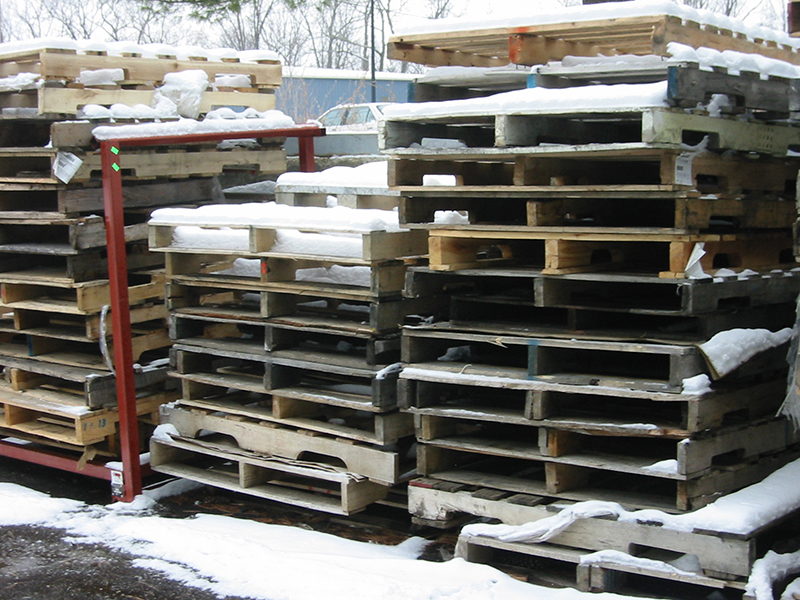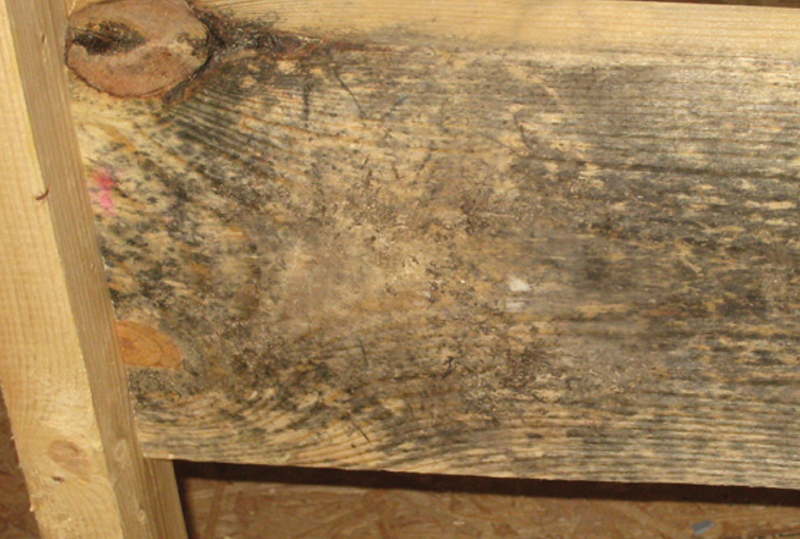Pallet mold is a major concern for manufacturers in a wide variety of industries. Not surprisingly, the food & beverage and pharmaceutical industries have always been concerned about mold on the pallets that they use, but purchase managers in many industries are starting to look at pallets with increased scrutiny as well. While mold has a minimal effect on the lifespan of the pallet itself, it can damage a manufacturer’s products, contaminate their production lines, and may even pose a health risk in the form of increased risk of asthma attacks for those who are sensitive to mold.
Pallet mold can be a serious problem, but the good news is that steps can be taken to prevent, inhibit, and remediate mold on wood pallets.
While there are many different molds, for the purpose of this discussion, mold is a type of fungus that produces pigmented spores and grows on the surface of wood products (among other things). There are literally thousands of molds that can land on a wood surface and grow. These fungi feed on the structural polymers, sugars, and proteins in the wood and generally produce spores that can become airborne. Some of these spores are clearly visible in black, white, green, orange, or purple spots, while others are not visible to the naked eye.
These spores can easily spread to other damp surfaces, including other woods products. Depending on the mold species, surfaces available, and environmental conditions, spores can grow and spread in a few days, but can also take months or even years to spread and grow.
The type of wood you use for your pallets and crates can also affect your risk of mold. Wood species with more stored sugars are at a higher risk, but no untreated wood is completely free from the risk of mold without proper care.
Mold presents on wood surfaces when conditions are favorable for growth. It requires four key elements to order to take root, survive and grow:
1. Moisture
In order for mold to grow on pallets, crates, and other wood packaging, it must have moisture. In general, pallets stored in a location with 60% humidity or greater have a better chance of becoming contaminated, but it’s not impossible for mold to grow in conditions with far less humidity. The moisture level of the wood itself also plays a role. Wood with greater than 19% moisture content also encourages mold growth. Your wood packaging should never be built from green or wet wood.
2. Oxygen
Mold requires oxygen to take root and grow. For obvious reasons, it’s impossible to control the oxygen levels in areas where wood or wood products are stored. On the other hand, vacuum-sealing products stored on wood pallets can help reduce the risk contamination.
3. Temperature
Many types of mold are capable of growing in a wide range of temperatures as long as moisture is present. In general, however, mold grows best in warm temperatures. Ideal temperatures for mold growth are between 70 and 85 degrees fahrenheit.
4. Food Source
If all other conditions are met with regard to moisture, oxygen, and temperature, the wood in your wood packaging becomes an ideal food source for many types of mold. Unfortunately, mold will also feed on the products that are stored on your pallets and crates. Nearly anything that contains natural sugars and proteins can become food for mold as well, including apparel, food & beverage products, pharmaceutical products, toys, household items, etc.

The best way to prevent mold from growing on your pallets, crates, and wood packaging is to stop it before it has a chance to start. As we’ve already discussed, pallet mold needs four key things to survive: moisture, oxygen, ideal temperatures, and food. For obvious reason, we can’t limit its food supply – the wood itself. It’s also unrealistic to try to limit the oxygen that surrounds pallets.
That leaves us with temperature and moisture.
For most manufacturers, keeping products stored in areas below 70 degrees or above 85 degrees isn’t feasible. Even if it were, that won’t necessarily prevent mold growth either.
So that means that controlling the moisture present in and around wood packaging is the best, and most realistic, way to prevent pallet mold. That means you must find a pallet manufacturer that uses best practices for keeping the moisture content of the wood they use low. Make sure your pallet manufacturer:
- Uses kiln dried lumber
- Stores lumber out of the weather
- Stores lumber with proper ventilation
Even if you use a pallet manufacturer that properly protects their wood from mold, and the wood packaging you receive from them is mold-free, you must also protect the finished pallets at your own manufacturing facility to ensure that pallets remain mold-free.
During Transport: Pallets should remain under cover and be well-ventilated. If transporting in a closed trailer, additional ventilation may be needed.
At the Warehouse: Pallets should remain indoor whenever possible. They should be stored where it is cool, dry, and there is good ventilation.
Kiln drying wood is one way to limit mold growth on pallets, crates, and wood packaging. It works, because it actually removes moisture from the wood and kills existing molds. If kiln dried wood comes into contact with moisture or is stored in a damp place at a later time, however, it can still experience mold colonization. Kiln drying is an important prevention strategy, but without proper storage it isn’t enough to prevent pallet mold.
Heat treating wood is different that kiln drying. Kiln drying involves stacking lumber inside large heated rooms to evaporate excess moisture. It’s really more of a curing process with the goal of preventing excessive warping of sawn lumber and reducing weight. It isn’t designed to be a sterilization process.
On the other hand, the goal of heat treating is to sterilize the wood, killing bugs and microorganisms, usually for export.
Heat treatment is designed to completely eradicate any and all living organisms in the wood, a process similar to pasteurization in other industries. While heat treating wood will kill pallet mold on or near the surface of the wood, it doesn’t actually dry the wood or reduce its moisture content. Any mold spores that find the wood after heat treatment can grow free of competition (because all surface organisms were killed during treatment), and can result in a potentially higher risk of pallet mold. In addition, heat treating wood draws moisture and sugar (mold food source) to the surface of the wood, and this can provide an ideal environment for mold growth.
In short, kiln drying helps prevent pallet mold because it removes moisture from the wood. Heat treating does not.
There are over 20 chemicals on the market that are registered to limit mold and fungi colonization of freshly sawn wood, and are designed to provide broad protection to wet wood. According to the National Wood and Pallet Association, the effectiveness of chemical treatments can range from three to six month, depending on storage circumstances and environmental factors. Chemicals are applied by spraying or dipping wood shortly after sawing.
Some industries prohibit the use of chemically treated pallets, crates, and wood packaging, and the FDA does not approve or disapprove chemical treatments.
Sometimes mold happens no matter how careful you are. If your industry has very strict requirements about mold, you may have to get rid of the pallet. If it truly is mold, and your industry has a zero mold tolerance, it may not be worth the time, effort, and money to save it. Purchasing new, mold-free pallets may be a better option.
On the other hand, many industries super concerned about mold. In those cases, there are some things you can try.

Is it really mold?
Often you’ll find discoloration on your wood packaging that appears to be pallet mold, but it’s not. These types of discolorations are biological and naturally occurring. They can include brown or iron stains, and discoloration from sun exposure, naturally occurring enzymes, or minerals.
Iron Stain: A very common type of black stain found on wood that’s caused by a reaction between elemental iron natural chemicals in the wood. It’s usually caused when metal comes into contact with the wood (like nails, staples, and fasteners). Even saw blades can cause an iron stain.
Sun Exposure: When wood is exposed to the sun, it will darken or even gray over time because the sun causes a chemical change to the tannins in the wood. This can make the wood look dirty or damaged.
Enzymatic Discolorations: Hardwood species are most commonly susceptible to this type of discoloration. It is discoloration caused by the enzymes found naturally occurring in the wood and can cause parts of the wood to gain a grayish or brownish tone.
Mineral Discolorations: These types of discolorations are seen as dark lines or streaks in oak, green or brown areas in maple, and even purple to black patches in yellow popular. It primarily happens in trees coming from mineral rich soils.
If you’ve determined that the irregularities you’re seeing are actually pallet mold, then you can take steps to remediate it. The good news is that mold on the surface of your pallets doesn’t structurally degrade the material in the short term. It’s also fairly simple, although time-consuming, to remove the mold.
1. Pressure wash the pallet
Pressure washing your pallets will remove the visible mold and make them much nicer to look at (if that’s a concern). Using a diluted bleach solution will kill the mold on the surface of your wood packaging, but it’s not a permanent fix. Be sure to check with your end customer before you use any kind of chemical on pallets. Some customers prohibit the use of any type of chemicals, including bleach.
Don’t stop at pressure washing. You have to kill the mold completely to keep it from coming back – see the next step below.
2. Kill the mold
It is difficult to kill pallet mold by treating it with chemicals. Chemicals, such as the bleach solution above, are really only a surface treatment and don’t get to the innermost layers of the wood where the pallet mold can survive. It’s likely that your pallets developed mold because their moisture content was too high in the first place. Spraying them with potentially dangerous chemicals isn’t going to solve that problem and the mold will return.
The best solution is to dry your pallets thoroughly. All the wood components on your wood packaging must reach a moisture content level below 19% in order to kill the mold. Pallet mold cannot survive in an environment where there is less than 19% moisture.
Once you’ve thoroughly dried your pallets, then you must keep them dry in order to keep the pallet mold away.
If you’ve made it all the way through this article, there’s one key takeaway: when it comes to pallet mold, moisture is your enemy.
While mold on wood packaging is a pretty big concern for a lot of industries, your best strategy for mold remediation is taking steps to prevent mold from taking root in the first place.
- Avoid recycled pallets that can often have mold on them, whether you see it or not.
- Use a trusted wood packaging provider that understands your needs for mold-free wood.
- Properly store your pallets with good airflow and cool temperatures.
- Keep your pallets dry. If they get wet, dry them out immediately.






